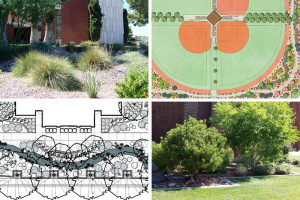 Master-planned communities are a testament to thoughtful urban design, seamlessly blending residential, commercial, and recreational spaces to create cohesive and vibrant neighborhoods. At the heart of these communities lies the functionality of landscape architecture, a discipline that goes beyond aesthetics to shape the very essence of how residents experience and interact with their surroundings. In this blog, we will delve into the pivotal role of landscape architecture in master-planned communities, emphasizing the significance of this discipline in creating sustainable, aesthetically pleasing, and community-centric living spaces.
Master-planned communities are a testament to thoughtful urban design, seamlessly blending residential, commercial, and recreational spaces to create cohesive and vibrant neighborhoods. At the heart of these communities lies the functionality of landscape architecture, a discipline that goes beyond aesthetics to shape the very essence of how residents experience and interact with their surroundings. In this blog, we will delve into the pivotal role of landscape architecture in master-planned communities, emphasizing the significance of this discipline in creating sustainable, aesthetically pleasing, and community-centric living spaces.
1. Crafting the urban tapestry:
Landscape architecture serves as the brushstroke that paints the urban canvas of master-planned communities. It involves the strategic arrangement of green spaces, parks, and recreational areas to create a harmonious balance between nature and human development. By carefully weaving together natural elements and built structures, landscape architects contribute to the creation of communities that are not only visually appealing but also conducive to a high quality of life.
2. Green infrastructure integration:
One of the hallmarks of sustainable master-planned communities is the integration of green infrastructure. Landscape architects work hand in hand with civil engineers to design stormwater management systems, green roofs, and permeable surfaces that reduce the environmental impact of urbanization. McNeil Engineering, with our comprehensive design services, is at the forefront of this synergy, ensuring that green infrastructure becomes an integral part of the community’s fabric.
3. Fostering community connectivity:
Landscape architects play a pivotal role in connecting communities through well-designed public spaces. Pedestrian-friendly walkways, bike paths, and communal gathering spots are carefully integrated to encourage social interaction and create a sense of unity within the community. Commitment to responsive design solutions ensures that these community-centric spaces are not just aesthetically pleasing but also functional and accessible to all who want to enjoy them.
4. Sustainable land use planning:
Master-planned communities are a testament to sustainable land use planning, and landscape architects are instrumental in optimizing the use of available space. By incorporating green buffers, preserving natural habitats, and strategically placing amenities, they contribute to a balanced and sustainable approach to development. McNeil Engineering’s landscape architecture services are tailored to align with these principles, ensuring that each community is a model of environmental stewardship.
5. Aesthetic identity and branding:
The visual identity of a master-planned community is carefully curated by landscape architects. From thematic design elements to the selection of plant species, every detail contributes to the unique aesthetic character of the community. McNeil Engineering understands the importance of creating distinctive identities for communities and provides landscape architecture services that capture the essence of each development while maintaining a cohesive overall vision.
6. Wellness-oriented design:
The significance of well-designed green spaces in promoting physical and mental well-being cannot be overstated. Landscape architects prioritize the creation of parks, recreational areas, and green corridors that enhance the overall wellness of residents. McNeil Engineering’s landscape architecture services are geared towards fostering a healthy living environment, contributing to the overall vitality of master-planned communities.
7. Resilient ecosystems and biodiversity:
Preserving and enhancing natural ecosystems within master-planned communities is a key consideration for landscape architects. By incorporating native plant species, creating wildlife corridors, and designing sustainable landscapes, they contribute to the resilience and biodiversity of the community. Commitment to ecological responsibility ensures that landscape architecture is a cornerstone in the preservation of natural habitats within the built environment.
8. Climate-responsive design:
As climate change becomes a critical consideration, landscape architects play a pivotal role in designing communities that are resilient to environmental challenges. From heat mitigation strategies to water conservation measures, their designs are tailored to respond to the unique climatic conditions of each location. McNeil Engineering’s landscape architecture services are founded on adaptability, creating communities that thrive in a changing climate.
9. Artistic expression and public art:
Landscape architecture goes beyond the functional aspects of design; it is also a form of artistic expression. Incorporating public art, sculptures, and installations into the fabric of master-planned communities adds cultural richness and fosters a sense of identity. McNeil Engineering’s comprehensive design services include landscape architecture that embraces the transformative power of art in shaping community spaces.
10. Long-term value and investment:
The impact of landscape architecture extends beyond the immediate aesthetics; it contributes to the long-term value and investment potential of master-planned communities. Well-designed and meticulously maintained landscapes enhance property values, attract businesses, and create a lasting legacy for residents. Economical design solutions ensure that the investment in landscape architecture translates into enduring value for the community and its stakeholders.
As we recognize the pivotal role of landscape architecture in the creation of master-planned communities, McNeil Engineering stands as a beacon of expertise and commitment to excellence. With a comprehensive suite of design services, including landscape architecture, McNeil Engineering has been at the forefront of shaping sustainable, visually stunning, and community-centric developments.
Visit McNeil Engineering to explore how our landscape architecture services can elevate your master-planned community. By choosing McNeil Engineering, you are not only investing in a design partner but also in a vision for a future where communities thrive in harmony with their natural surroundings. Let’s build the landscapes of tomorrow, together.








